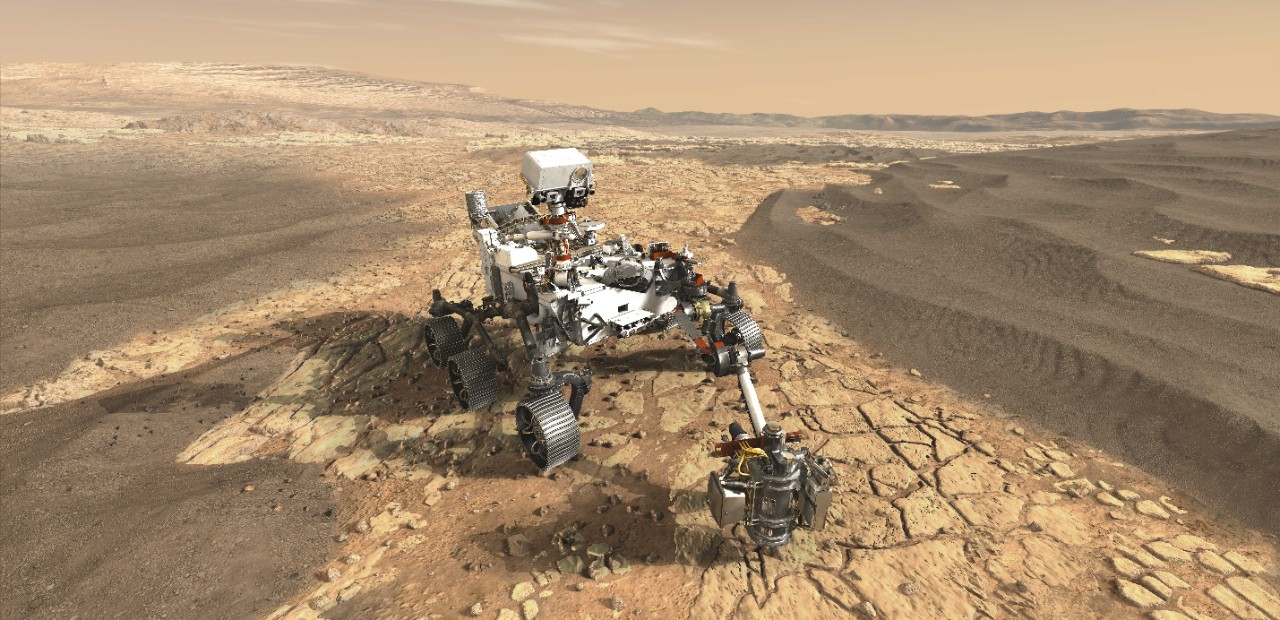
Mars rover mission has UC connections
Andy Czaja is on the science team that will look for evidence of ancient life on red planet
The world’s most advanced rover will begin looking for evidence of ancient life on Mars with the help of a University of Cincinnati astrobiologist.
The six-wheeled rover called Perseverance touched down safely on the red planet Friday after a seven-month voyage. Its mission: to look for signs of ancient life and collect samples for future study on Earth.
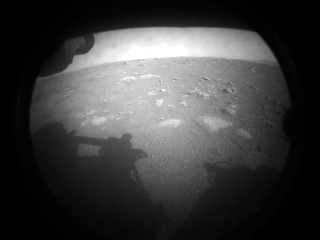
Perseverance used a low-resolution navigational camera to capture its first image of Jezero Crater moments after landing in its new home on Mars. The rover is equipped with high-resolution cameras that NASA hopes will capture stunning new images. Photo/NASA
Andy Czaja, an associate professor of geology in UC’s College of Arts and Sciences, serves on the NASA science team that is trying to confirm we are not alone in the universe by finding signs of ancient extraterrestrial life.
“If life forms separately on two planets in one solar system, that means it’s fairly easy for life to get started,” Czaja said. “And if we can prove Mars witnessed a separate origin of life, that’s very exciting. It means we have a high probability of finding life elsewhere in the universe, too.”
The project demonstrates UC's commitment to research as described in its strategic direction called Next Lives Here.

The Empire State Building in New York was illuminated in red to cheer on NASA's next Mars rover mission. Photo/NASA/Emma Howells
More UC connections
Czaja isn't UC's only tie to the next Mars mission.
Three UC College of Engineering and Applied Science graduates contributed to the Herculean feat of engineering. Sophia Mitchell, Rebecca Perkins and Stephanie Mitana played a role in preparing the rover and its complicated landing system called a sky crane.
A capsule containing the rover entered the Martian atmosphere, deploying a parachute to slow its descent. The capsule then ejected the rover and sky crane, a framework that used rockets to hover over the Martian surface before gently lowering the rover to the ground with cables.
Mitana worked on the sky crane system. Mitchell served as lead systems engineer for the gas dust removal tool on the rover's robotic arm. Previously, Mitchell worked with the Curiosity rover project at the Jet Propulsion Laboratory. Perkins started her career at NASA's Jet Propulsion Laboratory in 2012 and worked on the rover system that deploys tubes to collect mineral samples.
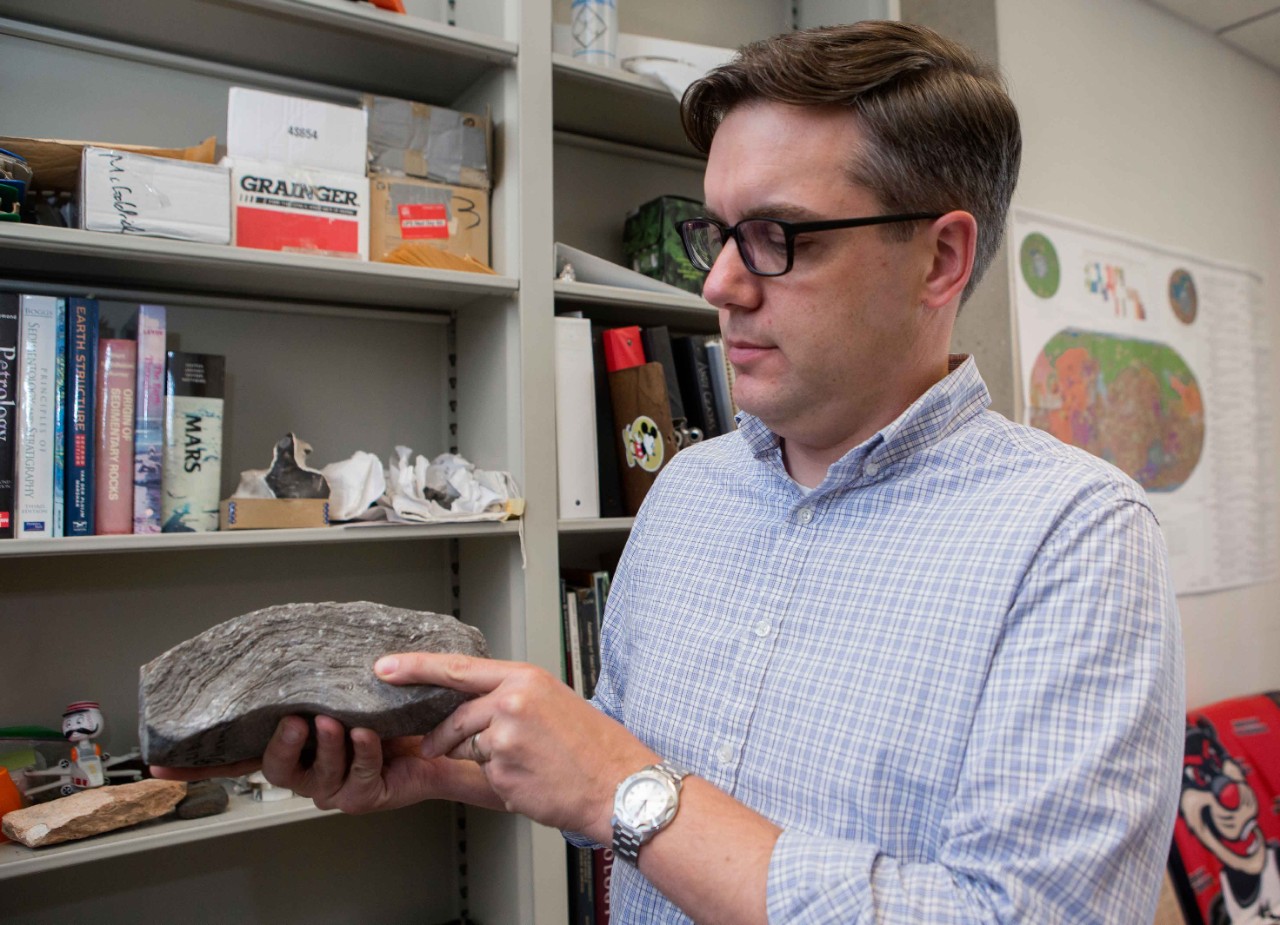
UC associate professor Andy Czaja helped NASA decide where on Mars to send its most advanced rover. Now he will serve on the science team using the rover to look for evidence of ancient life on the red planet. Photo/Joseph Fuqua II/UC Creative + Brand
Picking a destination
Czaja is an expert in Precambrian paleobiology, astrobiology and biogeochemistry.
He hopes to apply his expertise studying ancient life on Earth to help NASA do likewise on Mars. For a study published last month, Czaja photographed Earth's oldest known land fossils as part of an international research team.
He studies the early evolution of life on Earth in his geology lab at UC. In 2012, shortly before joining UC, he stayed up late to watch the landing of Curiosity on the surface of Mars. With the words “touchdown confirmed,” the control room at the Jet Propulsion Laboratory erupted into jubilant whoops and hugs.
Now he will be part of NASA’s next chapter of Mars exploration.
Czaja served on a NASA committee, the Returned Sample Science Board, that helped to choose Perseverance’s landing site called Jezero Crater. The 28-mile-wide crater contains what scientists say is a former river delta near the Martian equator.
“It’s a very good choice because the crater formed very early in Mars history,” Czaja said.
“We spent the last seven months since the launch planning how the mission will run depending on where we land in Jezero Crater,” Czaja said. “That way we can get to the science as soon as possible.”
There are so many big questions we have about this place.
Andy Czaja, UC associate professor of geology
Best of all, scientists believe it was full of water at one time.
“It was a crater lake,” Czaja said. “Water flowed flowed off the landscape into the crater and deposited a mass of sediment at the mouth of the river, like the Mississippi River Delta.”
Perseverance and the NASA team will undertake the most thorough and sophisticated examination for life on Mars to date.
Among other tasks, Perseverance will look for fossils long buried in the clay of the delta, Czaja said.
“If microbes were living there, they would fall onto the lake bottom and get buried. The fine-grained particles act to seal everything in and trap it. This happens on Earth,” he said.
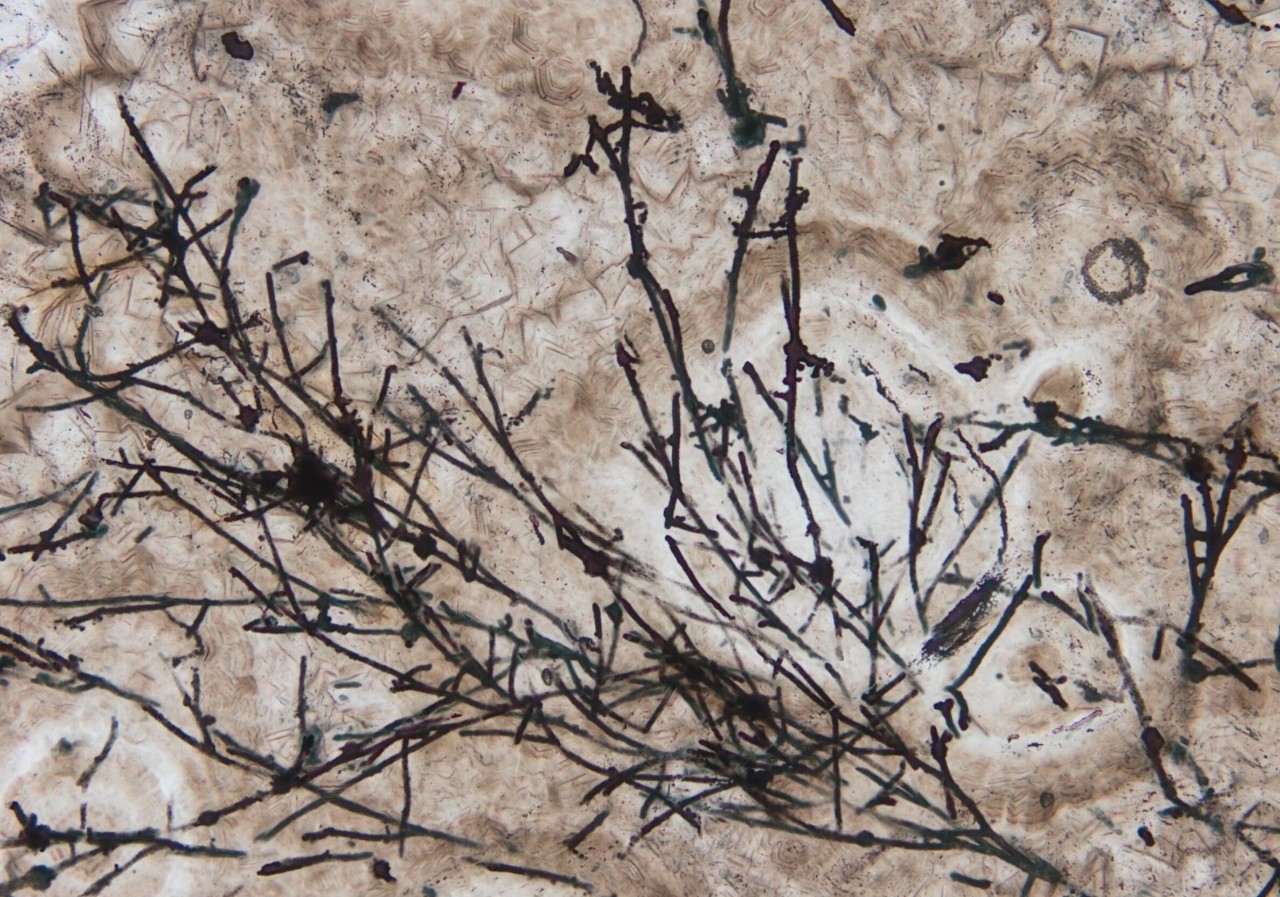
A microscopic image shows the oldest-known fungus microfossils on Earth. Photo by Andrew Czaja/University of Cincinnati.
Ancient life on Earth
Compared to Earth, the surface of Mars has seen far less erosion and active geological disturbance from plate tectonics. So if any evidence of life were deposited in those lake bottoms, it likely is still there, he said.
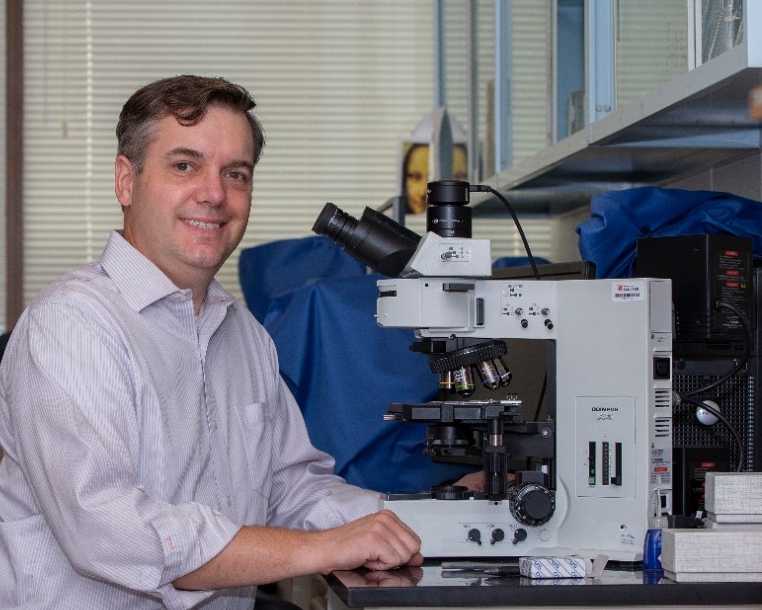
Andy Czaja works in his UC geology lab. Photo/Joseph Fuqua II/UC Creative + Brand
“Earth is extremely active with plates moving and colliding and mountains eroding and rain and wind and new oceans forming over millions and billions of years. Mars has been mostly inactive for billions of years,” he said.
The shallowest part of Jezero Crater might have evidence of carbonates that could provide evidence of ancient life on Mars. Czaja and his colleagues also will look for stromatolites, ancient rocks typically made of carbonate. On Earth, they form through the layering of year after year of photosynthetic bacteria.
The microbes secrete a sticky mat that binds with sediment and creates visible layers that persist long after the microbes have died and provide evidence of ancient life on Earth.
Stromatolites found in Australia date back more than 3.5 billion years, Czaja said.
The team also will look for evidence of organic carbon in the rocks.
“Organic carbon isn’t a slam dunk for life, but it’s consistent with life and would be an exciting find,” he said.
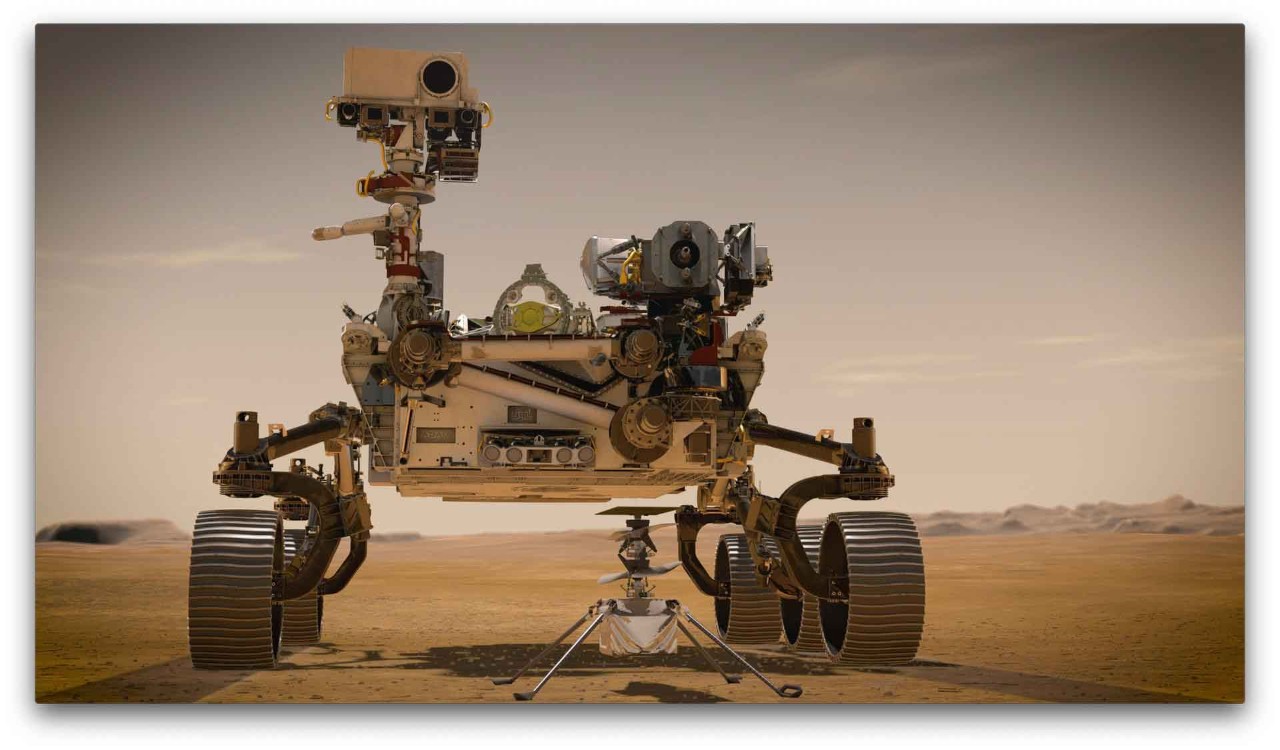
An artist's rendering of the rover Perseverance with its sidekick, Ingenuity, a 4-pound helicopter that will test powered flight on Mars. Illustration/NASA-JPL-Caltech
Breaking new ground
Jezero Crater also holds tantalizing possibilities for geologists as the possible site of former hot springs. Czaja and his students have studied hot springs in places like Yellowstone National Park to gain insight into ancient life on Earth.
“There are so many big questions we have about this place,” he said.
When you think of a fossil, you might imagine trilobites or the hard shells of brachiopods or even dinosaurs. But Czaja said the fossils Perseverance can search for are microscopic — single-celled organisms like those found on Earth that gave rise to nature’s varied splendor.
“It’s probably not reasonable to think you’ll find fossils that you can see with the naked eye,” he said. “But you can’t have larger organisms without microbial life. So if life was on Mars, you would expect to find evidence of microbial life.”
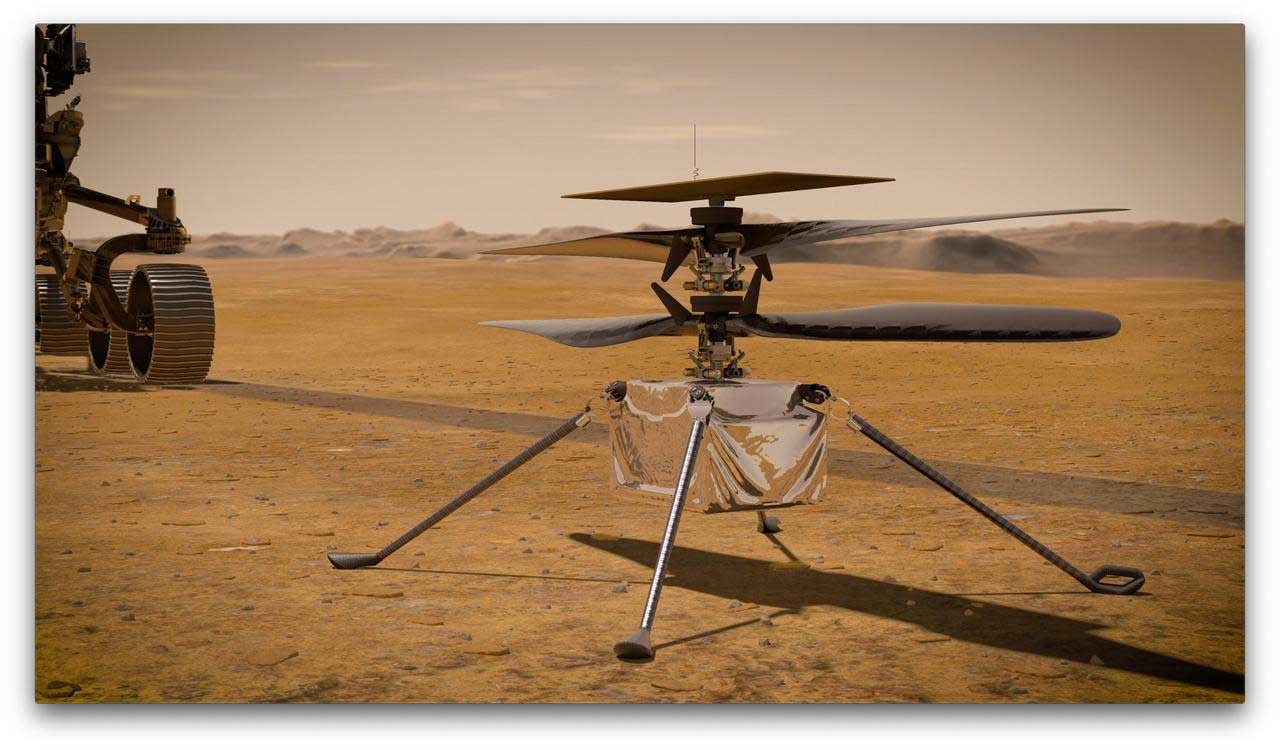
Ingenuity, the first interplanetary helicopter, will stow away in the belly of Perseverance for deployment on Mars. Illustration/NASA-JPL-Caltech
Also new to the mission: The rover will carry its own payload, an autonomous helicopter called Ingenuity that will be deployed to test powered flight in the thin Martian atmosphere. Similar aircraft could be useful tools for future science missions.
“I’m excited to see how the helicopter performs and to see aerial images of the rover and the region, a view we have never had on Mars before,” Czaja said.
Perseverance reached the surface of Mars by way of a “sky crane,” a rocket-powered platform that hovered over the Martian surface and dropped the rover to the ground using tethers.
“Parachutes don’t work as well in a thin Martian atmosphere,” Czaja explained.
NASA also will collect data on Mars’ geology and climate. It will collect promising samples chosen by scientists, place the samples in special containers and store them on the surface for a future retrieval mission.
But the rover’s suite of instruments will allow it to test the feasibility of harvesting local oxygen in the atmosphere for use as rocket propellant or breathable air. And like NASA’s other rovers, Perseverance will be able to document its mission with 19 cameras to capture the landscape and get detailed views of the Martian surface.
Perseverance is the largest, heaviest rover NASA has ever built. It’s one of the world’s most advanced autonomous robots.
“The more autonomous the rover can be, the better,” Czaja said. “It will be much faster than the last rover, Curiosity. It can cover much more distance in a shorter time because it has a better autonomous navigation system.”
NASA landed the rover Curiosity on Mars in 2012. It continues to provide images of Mars as it, too, searches for evidence of past microbial life. NASA said Curiosity is taking a “summer road trip” to navigate around a treacherous mile-long sand pit so it can continue its exploration.
Previously, NASA explored Mars with the twin rovers Spirit and Opportunity, which landed in 2004. In 1997, NASA deployed the rover Sojourner from the lander Pathfinder. Sojourner recorded 16,500 images of Mars during its three-month mission.
“I hope we can find evidence of ancient life on Mars,” Czaja said. “But I’m also looking forward to the discoveries we will make that we never even expected.”
Featured image at top: An early rendering of Perseverance on Mars. Illustration/Christian Mangano/NASA

UC associate professor Andy Czaja is helping NASA explore Mars in a quest for evidence of ancient life. Photo/Joseph Fuqua II/UC Creative + Brand
Impact Lives Here
The University of Cincinnati is leading public urban universities into a new era of innovation and impact. Our faculty, staff and students are saving lives, changing outcomes and bending the future in our city's direction. Next Lives Here.
Stay up on all UC's COVID-19 stories, read more #UCtheGood content, or take a UC virtual visit and begin picturing yourself at an institution that inspires incredible stories.
Related Stories
UC researcher launches app to connect patients to lifesaving...
May 7, 2025
A cardiologist and researcher at UC’s College of Medicine joined the Venture Lab at the 1819 Innovation Hub to launch High Enroll, an app that links clinical trials with willing participants.
The burning river that fueled a US green movement
May 5, 2025
An article by the BBC takes the reader back to the late 18th and 19th centuries, when US prosperity was defined by the industrial revolution, a time with little regard for the pollutants that came with industrial expansion. UC's David Stradling, professor of history, cited as expert source in the article.
UC students explore transformative trends shaping the future
May 5, 2025
Student researchers at the University of Cincinnati offer speculative looks at the future of healthcare, education and entertainment. We’ll break down their analysis of what to watch for.
